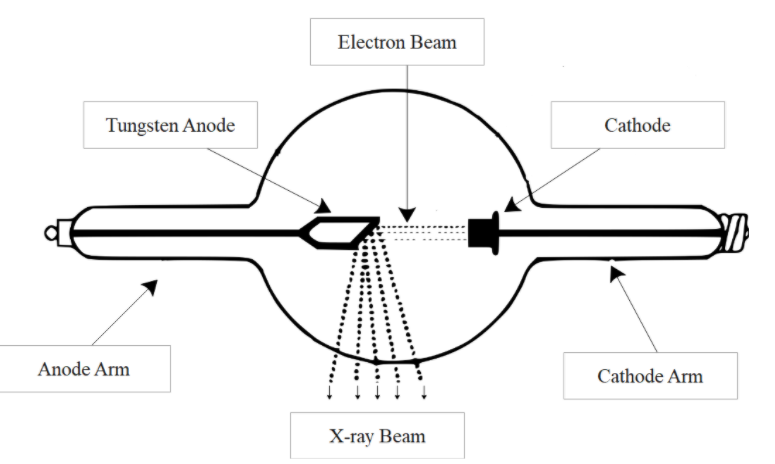
Water is circulated in Coolidge tube to –
A). Cool the target
B). Cool the cathode
C). Cool both cathode and target
D). None of these
Answer
583.5k+ views
Hint: The Coolidge tube has a high vacuum and it uses a heated filament as a source of electrons. Unlike cold cathode gas discharge tubes, there is so less amount of gas present in Coolidge tubes that it is not involved in the production of X-rays. We need to understand the working of a Coolidge tube in order to answer the question.
Complete step by step solution:
The Coolidge tube operates as follows:
i). While the cathode filament is heated, it emits electrons.
ii). Hotter the filament gets, greater is the emission of electrons.
iii). These electrons accelerate towards the positively charged anode.
iv). When these strike the anode, they change the direction and emit bremsstrahlung or X-rays, with a continuous energy range.
v). The maximum energy produced by X-rays is equivalent to the kinetic energy of the electrons that strike the anode.
vi). Additionally, some undesirable X-rays are also formed by electrons striking other components of the tube.
Below is a labelled diagram of a Coolidge tube.

The advantage of the Coolidge tube is that it is stable itself and provides stability to the system. Also, the intensity and energy of X-rays can be controlled independently with this tube and the increment in current to the cathode also increases its temperature leading to an increase in the number of electrons emitted by cathode resulting in the intensity of X-rays to be increased. Similarly, decreasing the current would give opposite effects. This process by which electrons are produced in the Coolidge tubes is known as thermionic effect and this comes from a tungsten filament that is heated by an electric current in the tube. For this reason, the Coolidge tube also needs to be cooled and water having high specific heat capacity can be used effectively as a coolant to lower the temperature of the target.
Hence, the correct option is Option A.
Note: Only a small fraction of the energy that is invested in an X-ray tube is actually converted into X-rays and less than 1% of the energy sent to the tube generates X-Ray, the rest is lost in the form of heat. This excessive heat produced in the X-ray could damage the apparatus and hence the cooling method is required. Therefore, water or oil as coolant comes into play.
Complete step by step solution:
The Coolidge tube operates as follows:
i). While the cathode filament is heated, it emits electrons.
ii). Hotter the filament gets, greater is the emission of electrons.
iii). These electrons accelerate towards the positively charged anode.
iv). When these strike the anode, they change the direction and emit bremsstrahlung or X-rays, with a continuous energy range.
v). The maximum energy produced by X-rays is equivalent to the kinetic energy of the electrons that strike the anode.
vi). Additionally, some undesirable X-rays are also formed by electrons striking other components of the tube.
Below is a labelled diagram of a Coolidge tube.

The advantage of the Coolidge tube is that it is stable itself and provides stability to the system. Also, the intensity and energy of X-rays can be controlled independently with this tube and the increment in current to the cathode also increases its temperature leading to an increase in the number of electrons emitted by cathode resulting in the intensity of X-rays to be increased. Similarly, decreasing the current would give opposite effects. This process by which electrons are produced in the Coolidge tubes is known as thermionic effect and this comes from a tungsten filament that is heated by an electric current in the tube. For this reason, the Coolidge tube also needs to be cooled and water having high specific heat capacity can be used effectively as a coolant to lower the temperature of the target.
Hence, the correct option is Option A.
Note: Only a small fraction of the energy that is invested in an X-ray tube is actually converted into X-rays and less than 1% of the energy sent to the tube generates X-Ray, the rest is lost in the form of heat. This excessive heat produced in the X-ray could damage the apparatus and hence the cooling method is required. Therefore, water or oil as coolant comes into play.
Recently Updated Pages
Master Class 12 Business Studies: Engaging Questions & Answers for Success

Master Class 12 Economics: Engaging Questions & Answers for Success

Master Class 12 English: Engaging Questions & Answers for Success

Master Class 12 Maths: Engaging Questions & Answers for Success

Master Class 12 Social Science: Engaging Questions & Answers for Success

Master Class 12 Chemistry: Engaging Questions & Answers for Success

Trending doubts
What is meant by exothermic and endothermic reactions class 11 chemistry CBSE

Which animal has three hearts class 11 biology CBSE

10 examples of friction in our daily life

One Metric ton is equal to kg A 10000 B 1000 C 100 class 11 physics CBSE

1 Quintal is equal to a 110 kg b 10 kg c 100kg d 1000 class 11 physics CBSE

Difference Between Prokaryotic Cells and Eukaryotic Cells




